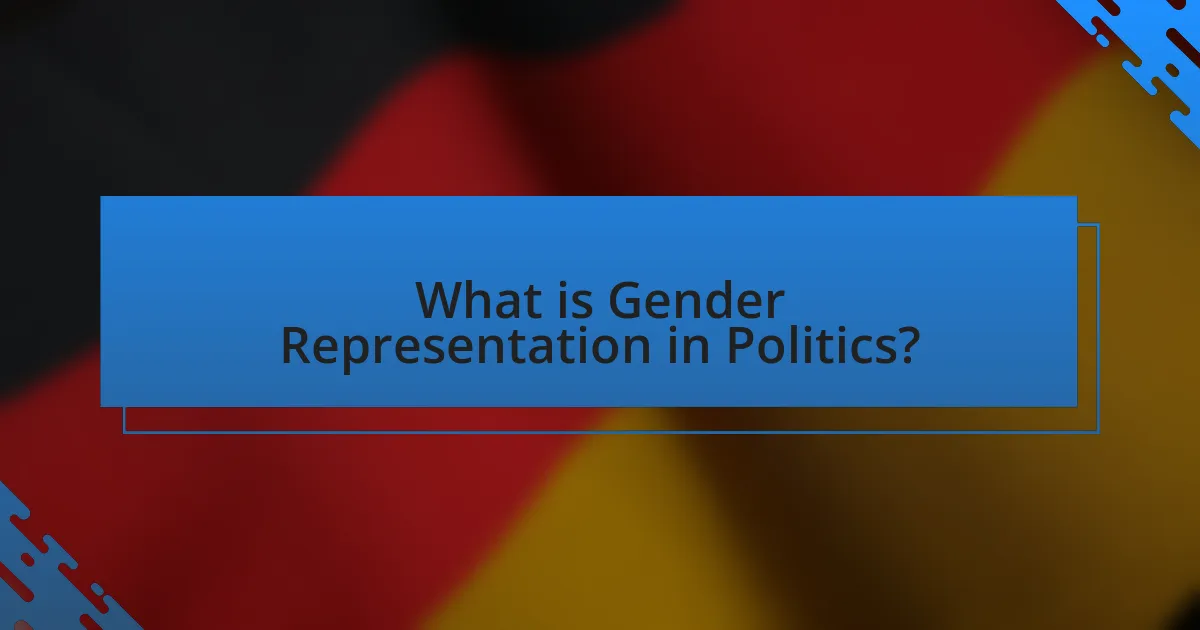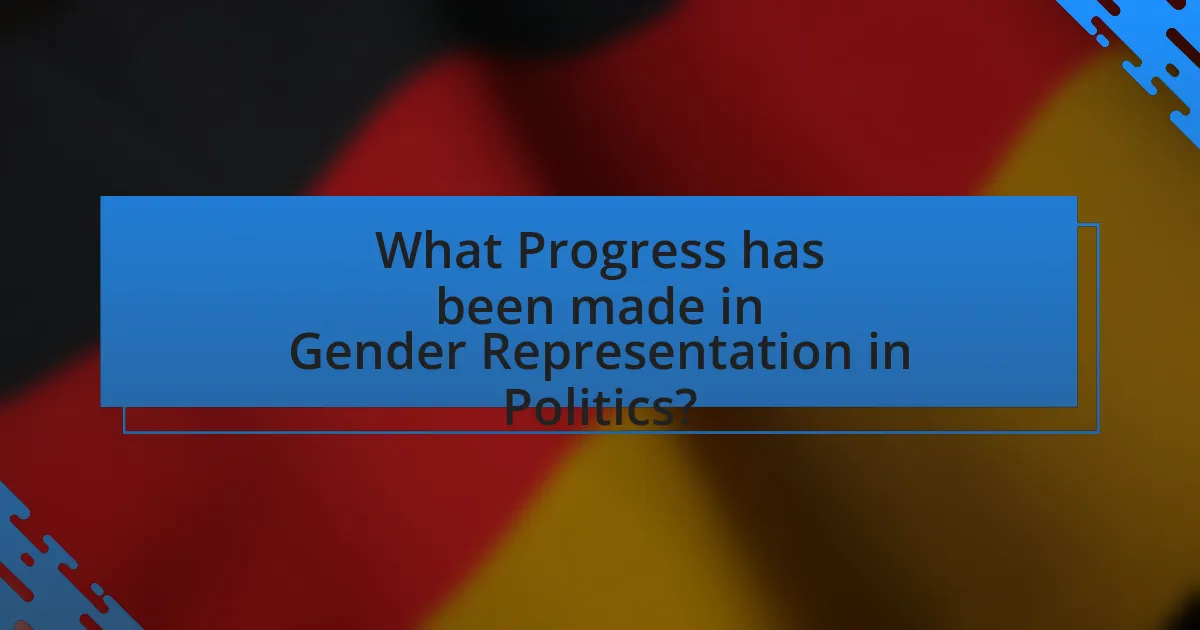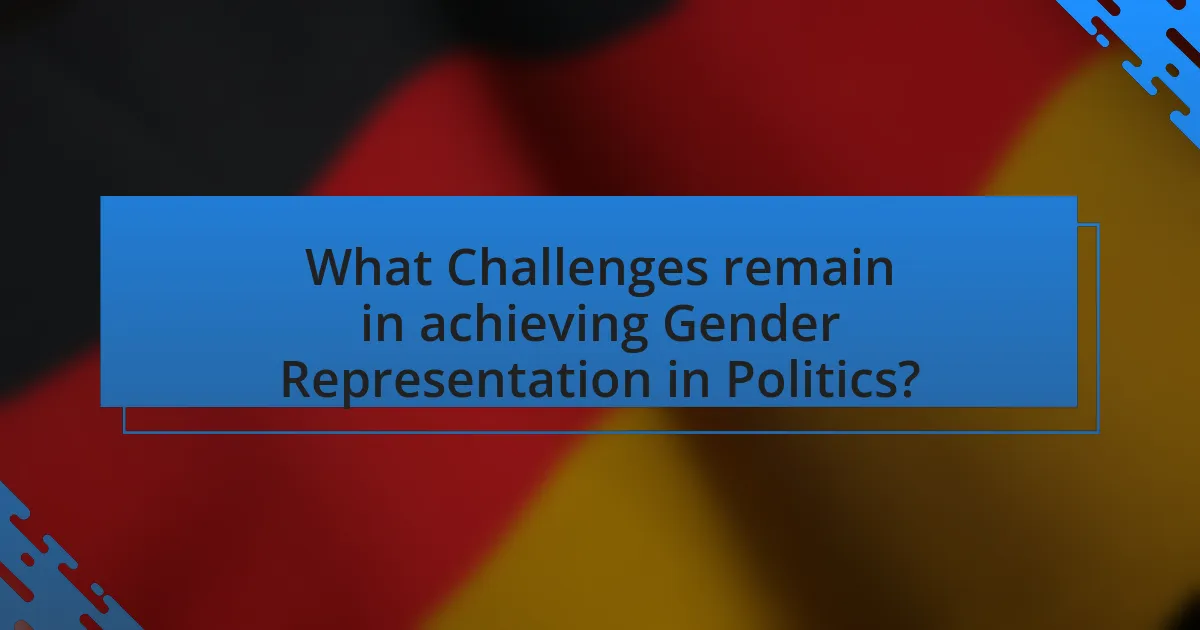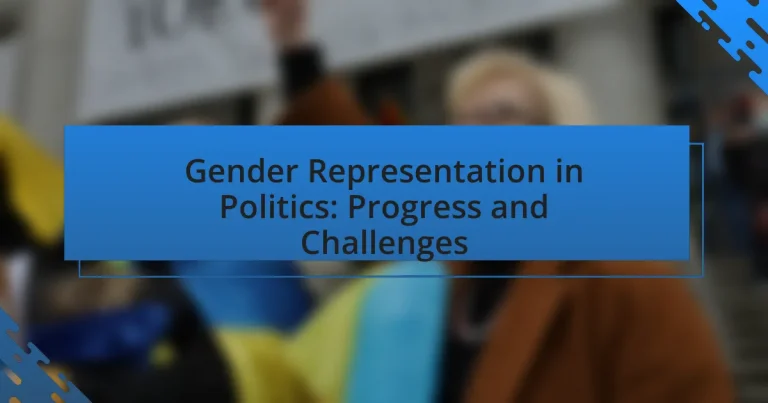Gender representation in politics refers to the equitable participation of individuals of different genders in political decision-making processes and institutions, emphasizing the need for diverse voices, particularly women, in governance. As of 2023, women hold approximately 26% of parliamentary seats globally, with significant disparities across countries, such as Rwanda’s 61% female representation compared to Japan’s 10%. The article explores the importance of gender representation in political systems, historical influences, current statistics, and the impact of female leaders on policy-making. It also addresses the challenges women face in entering politics, the role of political parties, and effective initiatives like gender quotas that have proven successful in enhancing women’s political participation.

What is Gender Representation in Politics?
Gender representation in politics refers to the equitable participation of individuals of different genders in political decision-making processes and institutions. This concept emphasizes the importance of having diverse voices, particularly women, in governance roles to ensure that policies reflect the needs and perspectives of the entire population. For instance, as of 2021, women held approximately 26% of parliamentary seats globally, highlighting ongoing disparities in gender representation. This statistic underscores the necessity for initiatives aimed at increasing women’s political participation to achieve more balanced and inclusive governance.
Why is Gender Representation important in Political Systems?
Gender representation is important in political systems because it ensures that diverse perspectives and experiences are included in decision-making processes. When women and marginalized genders are represented, policies are more likely to address the needs of the entire population, leading to more equitable outcomes. Research shows that countries with higher levels of gender representation in parliament, such as Rwanda, which has the highest percentage of women in government at over 60%, tend to have better social policies, including those related to health and education. This correlation highlights the significance of gender diversity in fostering comprehensive governance and promoting social justice.
What historical factors have influenced Gender Representation in Politics?
Historical factors that have influenced gender representation in politics include the suffrage movements, legal reforms, and social changes throughout the 20th century. The suffrage movements, particularly in the early 1900s, were pivotal as they fought for women’s right to vote, leading to significant legal changes such as the 19th Amendment in the United States in 1920, which granted women the right to vote. Additionally, the feminist movements of the 1960s and 1970s challenged traditional gender roles and advocated for equal representation, resulting in policies aimed at increasing women’s participation in politics. Furthermore, the introduction of quotas in various countries, such as Rwanda, which has the highest percentage of women in parliament globally, demonstrates how legislative measures can enhance gender representation. These historical milestones collectively shaped the landscape of gender representation in politics, leading to gradual but significant progress.
How does Gender Representation impact policy-making?
Gender representation significantly impacts policy-making by ensuring diverse perspectives are included in the decision-making process. When women and marginalized genders are represented in political bodies, policies tend to address issues such as healthcare, education, and social welfare more comprehensively. Research indicates that countries with higher levels of female representation, such as Rwanda, which has the highest percentage of women in parliament globally at over 60%, often implement more progressive social policies. This correlation suggests that gender-diverse leadership leads to more inclusive and equitable policy outcomes.
What are the current statistics on Gender Representation in Politics?
As of 2023, women hold approximately 26% of parliamentary seats globally, reflecting a gradual increase in gender representation in politics. This statistic indicates that while progress has been made, significant disparities remain. For instance, countries like Rwanda lead with over 60% female representation in their lower house, while others, such as Japan, report figures below 10%. The Inter-Parliamentary Union’s data highlights these variations, emphasizing the ongoing challenges in achieving gender parity in political institutions worldwide.
How do different countries compare in terms of Gender Representation?
Different countries exhibit significant variations in gender representation, particularly in political leadership roles. For instance, as of 2023, Rwanda leads globally with women holding 61.3% of parliamentary seats, attributed to policies promoting gender quotas. In contrast, countries like Japan and the United States lag, with women occupying only 10.2% and 27.3% of parliamentary seats, respectively, reflecting cultural and systemic barriers to female political participation. The Global Gender Gap Report 2022 by the World Economic Forum highlights these disparities, indicating that while some nations have made substantial progress, others continue to face challenges in achieving gender parity in political representation.
What trends have emerged in recent years regarding Gender Representation?
Recent years have seen a significant increase in gender representation in political positions globally. For instance, as of 2021, women held 26.1% of parliamentary seats worldwide, a notable rise from 11.3% in 1995, according to the Inter-Parliamentary Union. Additionally, countries like New Zealand and Rwanda have implemented gender quotas, resulting in higher female representation in their legislatures. This trend reflects a growing recognition of the importance of diverse perspectives in governance and has been supported by various international agreements, such as the United Nations’ Sustainable Development Goals, which advocate for gender equality in political participation.

What Progress has been made in Gender Representation in Politics?
Progress in gender representation in politics has been significant, with women holding approximately 26% of parliamentary seats globally as of 2023, a notable increase from 11% in 1995. This advancement is evidenced by various countries implementing gender quotas, which have proven effective in increasing female political participation. For instance, countries like Rwanda have achieved over 60% female representation in their lower house of parliament, largely due to constitutional mandates for gender parity. Additionally, the number of women serving as heads of state or government has also risen, with 15 women in such positions worldwide as of 2023, compared to only a handful two decades ago. These statistics reflect a broader trend towards greater inclusivity and representation of women in political decision-making processes.
What initiatives have been implemented to improve Gender Representation?
Various initiatives have been implemented to improve gender representation, including legislative quotas, gender parity laws, and targeted training programs for women in politics. Legislative quotas, such as those adopted in countries like Rwanda, mandate a certain percentage of women in political positions, resulting in Rwanda achieving over 60% female representation in its parliament. Gender parity laws, seen in nations like France, require equal numbers of male and female candidates in elections, significantly increasing women’s participation. Additionally, training programs, such as the UN Women’s “Women in Politics” initiative, provide skills and resources to empower women candidates, enhancing their chances of election and leadership roles. These initiatives collectively contribute to advancing gender representation in political spheres.
How effective have quotas and affirmative action policies been?
Quotas and affirmative action policies have been effective in increasing gender representation in politics. For instance, countries implementing gender quotas have seen a significant rise in women’s parliamentary representation; for example, Rwanda achieved over 60% female representation in its lower house due to such policies. Research by the Inter-Parliamentary Union indicates that nations with gender quotas have, on average, 20% more women in legislative positions compared to those without. This demonstrates that structured policies can lead to measurable improvements in gender equity within political systems.
What role do political parties play in promoting Gender Representation?
Political parties play a crucial role in promoting gender representation by establishing policies and practices that encourage the inclusion of women in political positions. These parties often implement gender quotas, which require a certain percentage of candidates to be women, thereby increasing female representation in legislative bodies. For instance, countries like Rwanda have achieved over 60% female representation in parliament due to such quotas enforced by political parties. Additionally, political parties can provide training and resources to female candidates, helping to overcome barriers to entry in politics. Research shows that when political parties actively support women’s candidacy, it leads to a more balanced and representative political landscape, ultimately enhancing democratic governance.
What successes can be highlighted in Gender Representation?
Significant successes in gender representation include the increase in women holding political office globally, with countries like Rwanda achieving over 60% female representation in parliament. This success is supported by legislative quotas that have been implemented in various nations, leading to a measurable rise in women’s participation in politics. For instance, as of 2021, the global average of women in national parliaments reached 25.5%, a notable increase from 11.3% in 1995, according to the Inter-Parliamentary Union. These advancements demonstrate a positive trend towards achieving gender parity in political representation.
Which countries have made significant strides in Gender Representation?
Countries that have made significant strides in gender representation include Rwanda, Sweden, and New Zealand. Rwanda leads globally with women holding 61% of parliamentary seats, a result of post-genocide reforms aimed at promoting gender equality. Sweden consistently ranks high, with women occupying 47% of its parliament, supported by policies that encourage female participation in politics. New Zealand has also made notable progress, with women comprising 49% of its parliament, reflecting a commitment to gender equity in governance. These statistics demonstrate the effectiveness of targeted policies and societal commitment to enhancing women’s representation in political spheres.
What impact have female leaders had on political landscapes?
Female leaders have significantly transformed political landscapes by promoting gender equality, enhancing policy focus on social issues, and inspiring future generations of women in leadership. For instance, countries led by female heads of state, such as Germany under Angela Merkel and New Zealand under Jacinda Ardern, have seen increased attention to issues like healthcare, education, and climate change. Research indicates that female leaders often prioritize collaborative governance and inclusive decision-making, which can lead to more comprehensive and effective policies. Furthermore, the presence of women in leadership roles has been shown to encourage greater female political participation, as evidenced by the rise in women candidates and voters in nations with female leaders.

What Challenges remain in achieving Gender Representation in Politics?
Challenges in achieving gender representation in politics include systemic barriers, cultural biases, and lack of support networks. Systemic barriers manifest in electoral processes that favor incumbents, often male, and in political party structures that do not prioritize gender diversity. Cultural biases perpetuate stereotypes about women’s roles, discouraging their participation in political life. Additionally, the lack of mentorship and support networks for women candidates limits their opportunities to run for office. According to the Inter-Parliamentary Union, as of 2021, women hold only 25.5% of parliamentary seats globally, highlighting the persistent underrepresentation and the need for targeted interventions to address these challenges.
What barriers do women face in entering politics?
Women face multiple barriers in entering politics, including systemic discrimination, lack of access to networks, and societal expectations. Systemic discrimination manifests in political structures that favor male candidates, often resulting in fewer opportunities for women to be nominated or elected. Additionally, women frequently encounter challenges in accessing influential political networks, which are predominantly male-dominated, limiting their ability to gain support and resources. Societal expectations and gender stereotypes further complicate women’s political ambitions, as traditional views often discourage women from pursuing leadership roles. According to the Inter-Parliamentary Union, as of 2021, women held only 25.5% of parliamentary seats globally, highlighting the persistent underrepresentation and barriers they face in the political arena.
How do cultural attitudes affect women’s political participation?
Cultural attitudes significantly influence women’s political participation by shaping societal norms and expectations regarding gender roles. In many cultures, traditional beliefs may prioritize male leadership and discourage women’s involvement in politics, leading to lower representation. For instance, a study by the Inter-Parliamentary Union in 2021 found that countries with more progressive gender norms tend to have higher percentages of women in political office, highlighting the correlation between cultural attitudes and political engagement. Additionally, cultural perceptions of women’s capabilities can affect their self-efficacy and willingness to run for office, further impacting their political participation.
What role does media representation play in shaping perceptions of women in politics?
Media representation significantly influences perceptions of women in politics by framing their roles, capabilities, and public image. Research indicates that media coverage often emphasizes stereotypes, portraying women as less competent or more emotional than their male counterparts, which can lead to biased public perceptions. For instance, a study by the Women’s Media Center found that women politicians receive less coverage than men and are often depicted in a more negative light, affecting voter attitudes and support. This skewed representation can hinder women’s political participation and reinforce gender biases in society.
What are the implications of underrepresentation of women in politics?
The underrepresentation of women in politics leads to significant implications for governance and policy-making. When women are not adequately represented, issues that disproportionately affect them, such as reproductive rights and gender-based violence, often receive less attention in legislative agendas. Research from the Inter-Parliamentary Union indicates that countries with higher female representation in parliament tend to have more progressive policies on gender equality and social welfare. Furthermore, the lack of women in political roles can perpetuate gender stereotypes and limit the diversity of perspectives in decision-making processes, ultimately affecting the quality of democracy and governance.
How does Gender Imbalance affect governance and democracy?
Gender imbalance negatively affects governance and democracy by limiting diverse perspectives and reducing the effectiveness of decision-making processes. When women are underrepresented in political positions, policies may not adequately address the needs and concerns of half the population, leading to governance that lacks inclusivity. For instance, research from the Inter-Parliamentary Union shows that countries with higher female representation in parliament tend to have more comprehensive social policies, including those related to health and education. This correlation highlights that gender-diverse governance can enhance democratic outcomes and societal well-being.
What are the long-term consequences of inadequate Gender Representation?
Inadequate gender representation leads to systemic inequalities that persist over time, affecting policy decisions and societal norms. Research indicates that when women are underrepresented in political positions, issues such as gender-based violence, reproductive rights, and economic inequality receive less attention and fewer resources. For instance, a study by the Inter-Parliamentary Union found that countries with higher female representation in parliament are more likely to pass legislation promoting gender equality. Furthermore, inadequate representation can perpetuate stereotypes and limit the diversity of perspectives in governance, ultimately hindering democratic processes and social progress.
What strategies can be employed to overcome challenges in Gender Representation?
To overcome challenges in gender representation, implementing targeted policies such as gender quotas can significantly enhance women’s participation in politics. Research indicates that countries with gender quotas, like Rwanda, have achieved over 60% female representation in parliament, demonstrating the effectiveness of such measures. Additionally, promoting mentorship programs for women in political careers can provide essential support and guidance, fostering a more inclusive political environment. Studies show that mentorship increases women’s confidence and likelihood of pursuing leadership roles, further addressing gender disparities in representation.
How can education and advocacy improve women’s political participation?
Education and advocacy can significantly improve women’s political participation by equipping them with the knowledge and skills necessary to engage in political processes and by raising awareness about the importance of their involvement. Education provides women with critical thinking skills, knowledge of political systems, and an understanding of their rights, which empowers them to participate actively in politics. For instance, studies show that women who receive political education are more likely to vote and run for office. Advocacy efforts, such as campaigns promoting women’s rights and representation, can shift societal attitudes and create supportive environments for women in politics. Research indicates that countries with strong advocacy movements for women’s rights see higher rates of female political participation, as seen in nations like Rwanda, where women hold over 60% of parliamentary seats due to both education initiatives and advocacy efforts.
What best practices can be adopted from successful countries?
Successful countries adopt best practices such as implementing gender quotas, promoting political education, and fostering inclusive political environments to enhance gender representation in politics. For instance, countries like Rwanda have established a constitutional mandate for a minimum of 30% of women in decision-making bodies, resulting in women holding over 60% of parliamentary seats. Additionally, Nordic countries emphasize political education and mentorship programs that empower women to engage in politics, leading to higher female representation. These practices demonstrate measurable outcomes in gender parity, as evidenced by the significant increase in women’s political participation in these nations.





